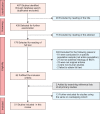Histologic distribution of borderline ovarian tumors worldwide: a systematic review
- PMID: 23346313
- PMCID: PMC3549507
- DOI: 10.3802/jgo.2013.24.1.44
Histologic distribution of borderline ovarian tumors worldwide: a systematic review
Abstract
Objective: The histologic types of borderline ovarian tumors (BOTs) exhibit striking differences in clinical behavior and prognosis. Yet, there is no information available on the histologic distribution of BOTs according to geographic region. The purpose of this study was to systematically review this issue worldwide.
Methods: A comprehensive search of the literature was conducted using electronic databases. Studies were eligible if BOTs were investigated and the histologic distribution of the data was shown. The studies were grouped by geographic region and totaled by country.
Results: Of 487 potentially relevant studies, 51 met our inclusion criteria, as follows: 8 studies from North America (2 countries); 26 studies from Europe (14 countries); 7 studies from the Middle East (3 countries); and 10 studies from East Asia (5 countries). The histologic distribution of BOTs was considerably different in different parts of the world, but follows specific patterns. In general, serous-type BOTs were the predominantly identified histology in North America, the Middle East, and Europe, while mucinous-type BOTs predominated in East Asia.
Conclusion: Significant geographic variation is evident among BOT histology in different parts of the world. More research is needed to understand this phenomenon.
Keywords: Borderline ovarian tumor; Histology; Low malignant potential; Systematic review.
Conflict of interest statement
No potential conflict of interest relevant to this article was reported.
Figures
Similar articles
-
Risk of specific types of ovarian cancer after borderline ovarian tumors in Denmark: A nationwide study.Int J Cancer. 2020 Aug 15;147(4):990-995. doi: 10.1002/ijc.32864. Epub 2020 Jan 21. Int J Cancer. 2020. PMID: 31930502
-
Borderline ovarian tumors: Guidelines from the French national college of obstetricians and gynecologists (CNGOF).Eur J Obstet Gynecol Reprod Biol. 2021 Jan;256:492-501. doi: 10.1016/j.ejogrb.2020.11.045. Epub 2020 Nov 20. Eur J Obstet Gynecol Reprod Biol. 2021. PMID: 33262005
-
Borderline ovarian tumors: French guidelines from the CNGOF. Part 1. Epidemiology, biopathology, imaging and biomarkers.J Gynecol Obstet Hum Reprod. 2021 Jan;50(1):101965. doi: 10.1016/j.jogoh.2020.101965. Epub 2020 Nov 4. J Gynecol Obstet Hum Reprod. 2021. PMID: 33160106
-
The preoperative diagnosis of borderline ovarian tumors: a review of current literature.Arch Gynecol Obstet. 2012 Apr;285(4):1103-12. doi: 10.1007/s00404-011-2194-1. Epub 2011 Dec 31. Arch Gynecol Obstet. 2012. PMID: 22210294 Review.
-
The Putative Role of TP53 Alterations and p53 Expression in Borderline Ovarian Tumors - Correlation with Clinicopathological Features and Prognosis: A Mini-Review.J Cancer. 2017 Aug 22;8(14):2684-2691. doi: 10.7150/jca.19691. eCollection 2017. J Cancer. 2017. PMID: 28928856 Free PMC article. Review.
Cited by
-
Borderline tumour recurrence: how quickly does the tumour grow?BMJ Case Rep. 2024 May 9;17(5):e259501. doi: 10.1136/bcr-2023-259501. BMJ Case Rep. 2024. PMID: 38724214
-
Fertility-sparing surgery versus radical surgery for micropapillary serous borderline ovarian tumours: a systematic review protocol.BMJ Open. 2024 Nov 12;14(11):e077503. doi: 10.1136/bmjopen-2023-077503. BMJ Open. 2024. PMID: 39532361 Free PMC article.
-
Borderline tumors of the ovary: A clinicopathological study.Pak J Med Sci. 2017 Mar-Apr;33(2):369-373. doi: 10.12669/pjms.332.11847. Pak J Med Sci. 2017. PMID: 28523039 Free PMC article.
-
Risk factors that increase recurrence in borderline ovarian cancers.Am J Transl Res. 2021 Jul 15;13(7):8438-8449. eCollection 2021. Am J Transl Res. 2021. PMID: 34377341 Free PMC article.
-
Establishment of Two Novel Ovarian Tumor Cell Lines with Characteristics of Mucinous Borderline Tumors or Dedifferentiated Carcinoma-Implications for Tumor Heterogeneity and the Complex Carcinogenesis of Mucinous Tumors.Cancers (Basel). 2025 May 20;17(10):1716. doi: 10.3390/cancers17101716. Cancers (Basel). 2025. PMID: 40427213 Free PMC article.
References
-
- Taylor HC., Jr Malignant and semimalignant tumors of the ovary. Surg Gynecol Obstet. 1929;48:204–230.
-
- Cadron I, Leunen K, Van Gorp T, Amant F, Neven P, Vergote I. Management of borderline ovarian neoplasms. J Clin Oncol. 2007;25:2928–2937. - PubMed
-
- Koskas M, Uzan C, Gouy S, Pautier P, Lhomme C, Haie-Meder C, et al. Fertility determinants after conservative surgery for mucinous borderline tumours of the ovary (excluding peritoneal pseudomyxoma) Hum Reprod. 2011;26:808–814. - PubMed
-
- Uzan C, Kane A, Rey A, Gouy S, Duvillard P, Morice P. Outcomes after conservative treatment of advanced-stage serous borderline tumors of the ovary. Ann Oncol. 2010;21:55–60. - PubMed
-
- Silverberg SG, Bell DA, Kurman RJ, Seidman JD, Prat J, Ronnett BM, et al. Borderline ovarian tumors: key points and workshop summary. Hum Pathol. 2004;35:910–917. - PubMed
LinkOut - more resources
Full Text Sources
Other Literature Sources
Miscellaneous



